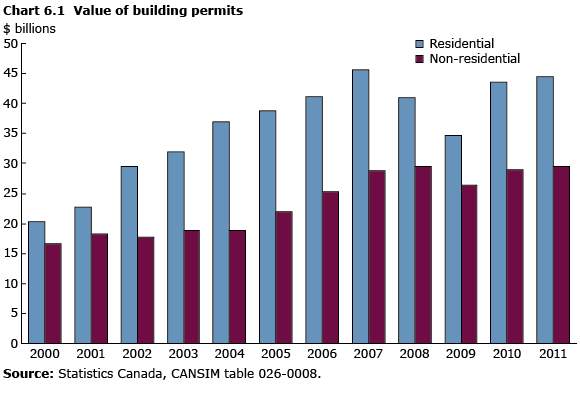Construction
Archived Content
Information identified as archived is provided for reference, research or recordkeeping purposes. It is not subject to the Government of Canada Web Standards and has not been altered or updated since it was archived. Please "contact us" to request a format other than those available.
Related information
In 2011, the construction industry outpaced the overall economy in both output and employment growth.
Construction accounted for 6.0% of Canada's GDP in 2011, contributing $76.5 billion. The industry grew 4.2% from 2010, greater than Canada's overall GDP growth of 2.6%. The strongest component was engineering, repair and other construction activities, which gained 7.0%. The other two components were residential building construction, which rose 1.6%, and non-residential building construction, up 0.4%.
From 2010 to 2011, construction employment rose by 3.7%, compared with 1.5% in all industries. Roughly 1.3 million people worked in construction in 2011, making it the fifth-largest employer by industry and accounting for 7.3% of jobs among all industries.
Building permits back to pre-recession levels
The value of building permits issued has increased every year since 1995, except during the 2008–2009 recession. In 2011, the total value was $74.0 billion, up 2.1% from 2010, and just below the pre-recession peak of $74.4 billion in 2007.
Of this total value, $44.5 billion was for residential buildings, up 2.3% from 2010; $29.5 billion was for non-residential building permits, a gain of 1.8%. Most of the non-residential permits were for commercial buildings—worth $16.3 billion, up 6.0% from 2010. Permits valuing $8.0 billion were issued for institutional and governmental buildings, a decrease of 5.6% from 2010; industrial building permits valued $5.2 billion, a gain of 1.5%.
Among the provinces, Ontario had the highest value of building permits with $28.0 billion, down 0.4% from 2010; Quebec was second with $15.5 billion, up 4.4% from 2010.
The Prairie provinces saw the largest annual gains in 2011: together, they rose 12.9% to $17.2 billion. Among the provinces, Saskatchewan had the highest increase across the Prairies and all of Canada, up 25.9% to a value of $2.6 billion.
The Atlantic provinces saw the largest declines of 2011—11.9% to $3.7 billion. New Brunswick fell farthest, down 14.8%. In Saint John, building permit values dropped 24.8%.
Among Canada's 33 census metropolitan areas, the biggest contributor was Toronto, where $14.2 billion in permits was issued in 2011, an increase of 9.6%. Montréal issued $7.9 billion in permits, a 19.7% increase. Saskatoon posted the sharpest gain, up 33.1% to $1.1 billion.
Housing starts on the rise
In 2011, 193,950 housing starts were registered, up 2.1% from 2010. There were 174,437 houses under construction at the end of 2011, a 9.3% increase from 2010, while 175,623 houses were completed, a 6.0% drop.
The majority of housing starts were in Ontario (67,821 units) and Quebec (48,387 units), up 12.2% and down 5.8% from 2010, respectively. Prince Edward Island posted the strongest increase of all the provinces, 24.3%, followed by Saskatchewan, up 19.0%. In New Brunswick, starts fell 15.8% from 2010, the largest decline in the provinces.
In 2011, 111,558 multiple-unit housing starts were posted, up 14.6% from 2010. Among the multiple-unit starts, the majority were apartment and other unit types (79,541 units), followed by row housing (19,447) and semi-detached (12,570). Single-detached housing starts were down 11.0% to 82,392.
Multiple units lead investment in new dwellings
Investment in new dwellings increased 3.8% in 2011 to $41.0 billion. Apartment building investment rose 32.2% from 2010; row housing advanced 8.8%; and double housing, 2.4%. Investment in single housing fell 6.6%.
The strongest gains in construction investment were in Nunavut (65.6%), Saskatchewan (49.7%) and Ontario (11.7%), with apartment housing the greatest contributor to growth. Investment fell the most in the Northwest Territories (33.7%), with large drops in double housing and apartments, and Alberta (10.3%), mostly owing to a decline in single housing.
Provincially, the highest overall residential investment was in Ontario ($14.4 billion), Quebec ($9.0 billion) and Alberta ($6.6 billion).
In 2011, $44.6 billion was invested in non-residential construction, up 3.8% from 2010. Newfoundland and Labrador (68.4%) and Prince Edward (56.1%) saw the sharpest growth. The largest drops were posted in the Northwest Territories (35.9%) and Nunavut (24.1%), followed by Alberta (9.5%) and Saskatchewan (6.5%).
Non-residential investment was highest in Ontario ($18.3 billion), followed by Alberta ($8.5 billion), Quebec ($7.6 billion) and British Columbia ($5.1 billion).

View data source for chart 6.1
- Date modified:
